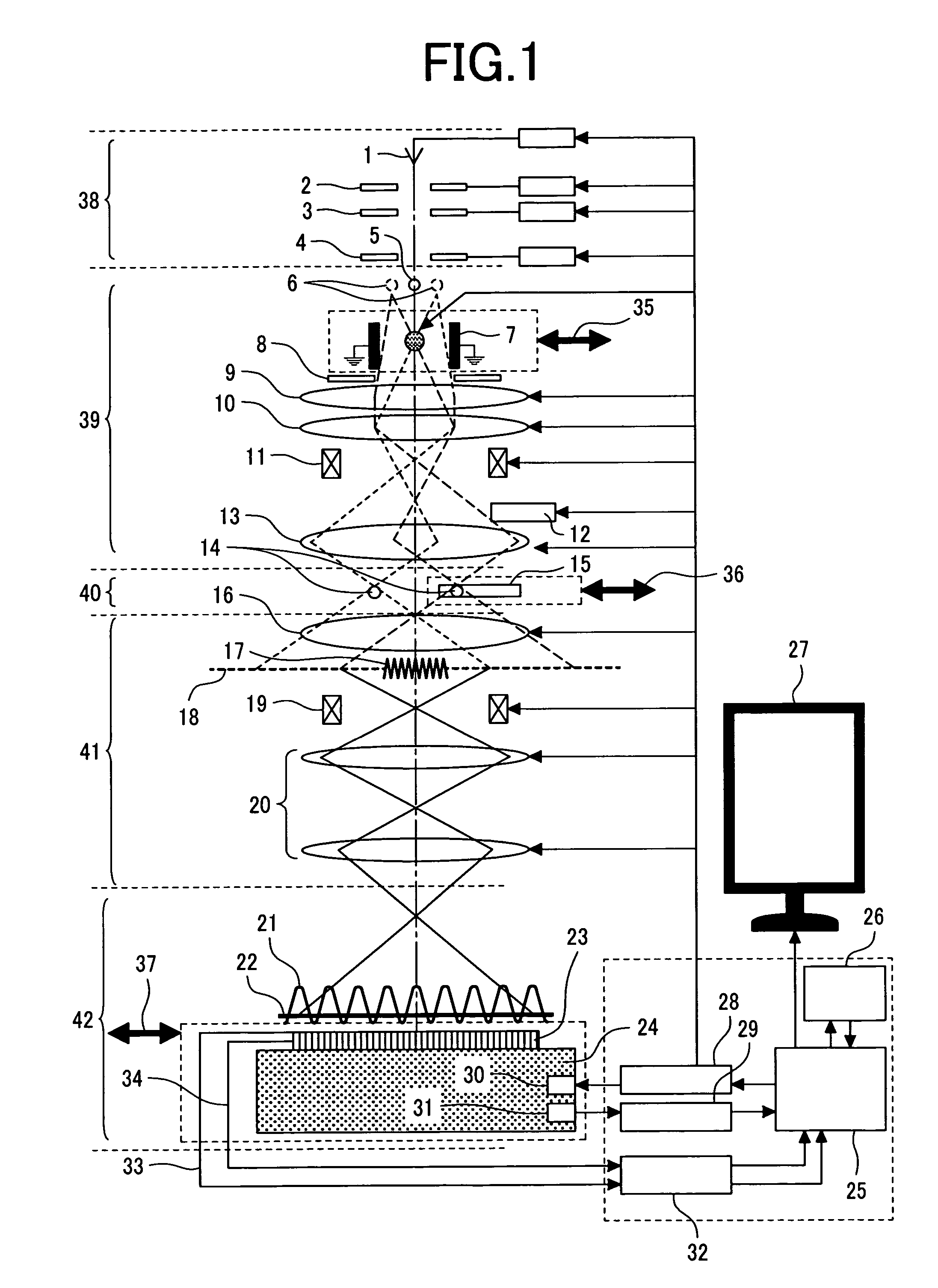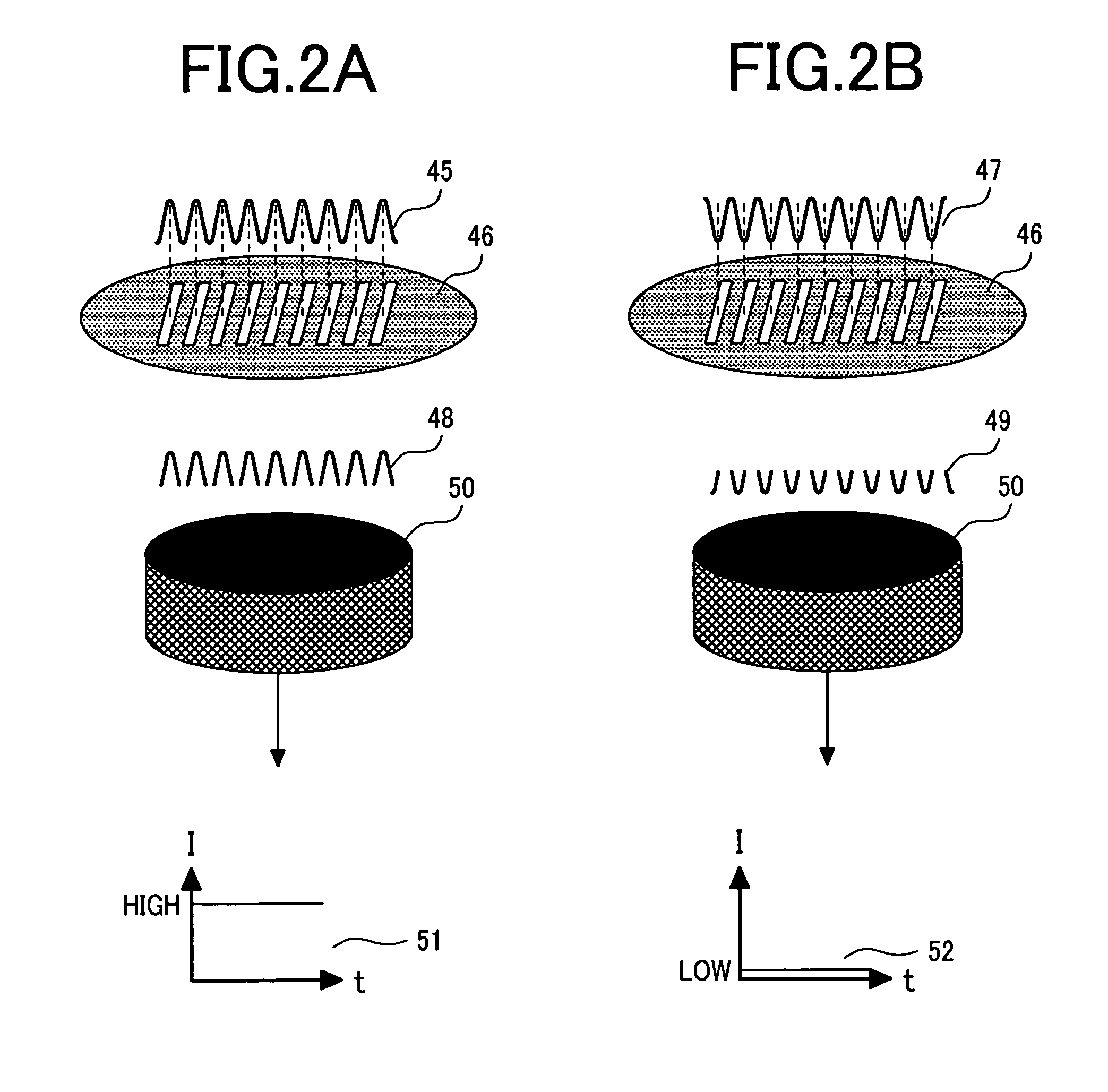Scanning interference electron microscope
an electron microscope and scanning interference technology, applied in the field of scanning interference electron microscopes, can solve the problems of complex and difficult adjustment, low detection efficiency of electron beams, etc., and achieve the effects of improving detection sensitivity or detection precision, high sensitiveness, and easy adjustment and adjustmen
- Summary
- Abstract
- Description
- Claims
- Application Information
AI Technical Summary
Benefits of technology
Problems solved by technology
Method used
Image
Examples
first embodiment
[0032]In this embodiment, an example where the present invention is applied to STEM will be described. FIG. 1 shows an example of a configuration of an STEM of this embodiment. The STEM of this embodiment comprises an electron gun 38, an illumination system 39, a specimen chamber 40, an imaging system 41, a detection system 42, a control system, etc., as a rough breakdown of the STEM.
[0033]The electron gun 38 of the STEM of this embodiment consists of an electron source 1, a first anode 2, a second anode 3, an acceleration anode 4, etc. The illumination system 39 consists of an electron biprism 7, a condenser aperture 8, a first condenser lens 19, a second condenser lens 10, a scanning coil 11, an objective lens pre-field 13, an objective lens post-field 16, etc. In addition, although not illustrated specifically, the electron biprism 7 is equipped with an electron biprism fine positioning system 35, and is made movable by this. The imaging system 41 and the detection system 42 cons...
second embodiment
[0063]FIGS. 8A to 8D show another example of this embodiment. In this example, this embodiment is applied to dopant profile evaluation of a semi-conductor transistor. First, a voltage is applied to the electron biprism in the absence of specimen, the interference fringes magnified with an imaging lens is made to be incident on the asymmetric 2-dimensional detector with integration capability. After that, the electron beams are deflected with a deflection coil, and thereby the electron beams take an arrangement as shown in FIG. 8A. Here, one of two splitted electron beam spots 98, 99 is adjusted to pass through a vacuum and the other is adjusted to transmit through the specimen. Next, the two splitted electron beam spots are scanned in a direction of scanning 100, and at each predetermined scanning distance, the interference fringes are acquired. FIG. 8B shows a comparative relation between the specimen and the electron beam spot at the time when the electron beam is scanned as far a...
third embodiment
[0064]FIGS. 9A to 9D show further another example of the embodiment. In this, the STEM is applied to magnetic domain structure evaluation of a magnetic thin film. First, in the absence of specimen, a voltage is applied to the electron biprism and interference fringes magnified with an imaging lens are made to be incident on the asymmetric 2-dimensional detector with integration capability. After that, by deflecting the electron beam with a deflection coil, the electron beams take an arrangement as shown in FIG. 9A. Here, two splitted electron beam spots 108, 109 are so adjusted that one of them passes through a vacuum in proximity to the specimen and the other transmits through the specimen.
[0065]Next, while the two splitted electron beam spots are being scanned in a direction of scanning 110, the interference fringes are acquired at each predetermined scanning distance. FIG. 9B shows a comparative relation between the specimen and an electron beam spot at a time when the electron b...
PUM
| Property | Measurement | Unit |
|---|---|---|
| rotation angle | aaaaa | aaaaa |
| scanning interference electron microscope | aaaaa | aaaaa |
| scanning interference microscope | aaaaa | aaaaa |
Abstract
Description
Claims
Application Information
 Login to View More
Login to View More - R&D
- Intellectual Property
- Life Sciences
- Materials
- Tech Scout
- Unparalleled Data Quality
- Higher Quality Content
- 60% Fewer Hallucinations
Browse by: Latest US Patents, China's latest patents, Technical Efficacy Thesaurus, Application Domain, Technology Topic, Popular Technical Reports.
© 2025 PatSnap. All rights reserved.Legal|Privacy policy|Modern Slavery Act Transparency Statement|Sitemap|About US| Contact US: help@patsnap.com



